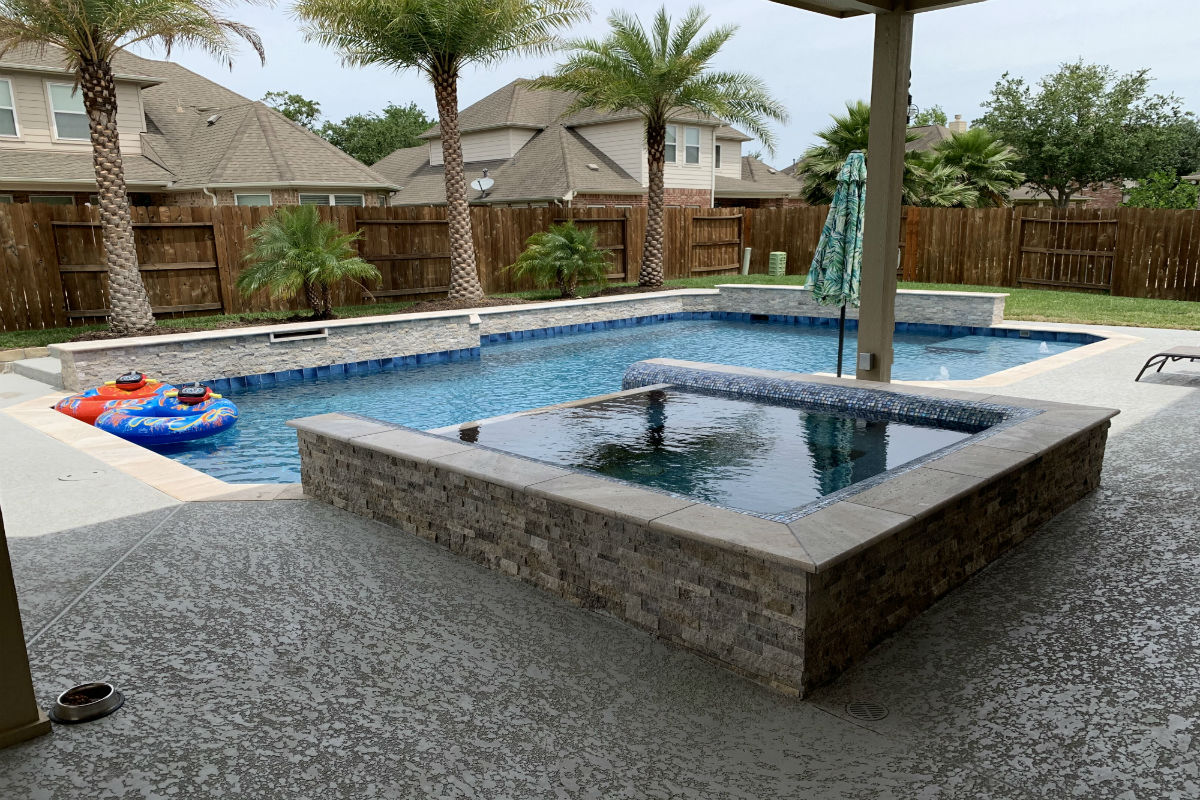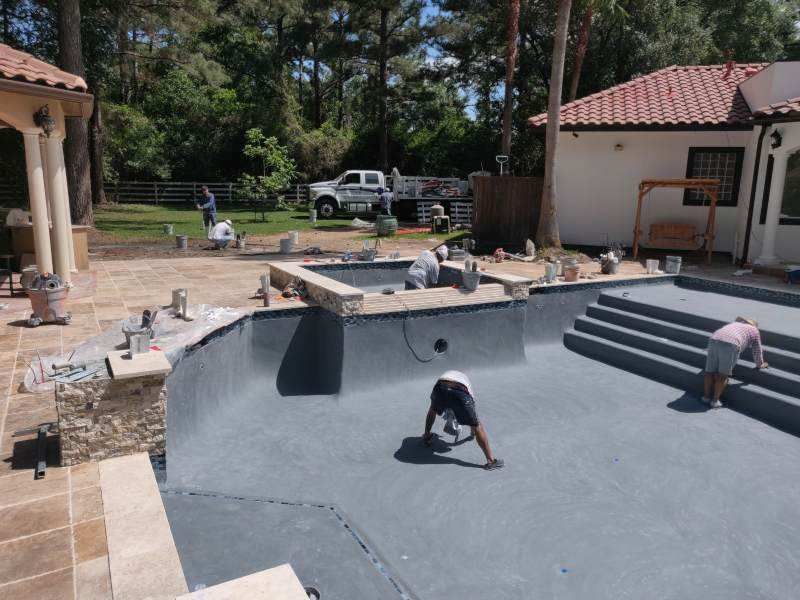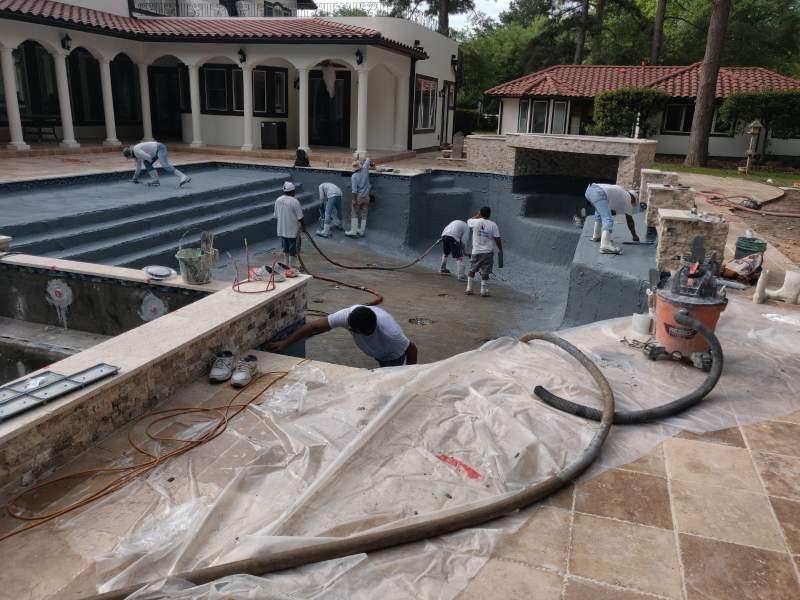River Oaks, TX Pool Plaster
Our Pool Plaster Company Is Excellent At What It Does
No one knows better than JR Pool Plastering & Texas Gunite Ltd. when it comes to River Oaks, TX pool plaster. Your pool plaster is an important part of your pool, both functionally and aesthetically. It protects your pool’s shell, which forms the shape of your pool, from wear and tear. It also forms the surface of your pool, providing a smooth wall that can add aesthetic value to your pool’s design.

JR Pool Plastering & Texas Gunite is the premier pool plaster repair company in the area.
So, of course, when your pool’s plaster is out of shape, you’ll need to resurface it to restore it to its original form. Pool plaster can stain, crack, spall, and show other signs of wear and tear after several years of being underwater and pool chemicals. No matter what the circumstances are, the best solution is to replaster your pool with a fresh coat before it can get any worse.
JR Pool Plastering & Texas Gunite is your local expert for repairing and remodeling pools. With us in charge, your plaster can return to its original clean and beautiful state. You can even take this chance to change the material of the plaster or plaster color. We use high-quality Wet Edge products and finishes, so you know your plaster will look amazing for a longer time than before.
Choosing Your Favorite River Oaks, TX Pool Plaster
When discussing pool plasters, it’s critical to consider the range of solutions available. Each has special advantages based on aesthetic preferences, financial constraints, and maintenance requirements. Pool plaster is essential for the longevity and comfort of the pool, in addition to its aesthetics.
Traditionally, Standard White Plaster is the least expensive alternative. Composed of a blend of marble dust and white cement, it offers a timeless, tidy appearance. Over time, though, it becomes more prone to staining and etching, especially if the pool water is not properly balanced.
Pigments are added to ordinary plaster to create Colored Plaster, which comes in a range of colors from light blues and greys to greens and even black. This may contribute to the appearance of deeper seas. Colored plaster is more aesthetically pleasing than plain white plaster, but it can also fade or become mottled, especially in direct sunshine or after being exposed to chemicals.
Quartz Plaster is an improved version of traditional plaster. When combined with quartz aggregate, it greatly improves the plaster’s resilience to stains, dullness, and chemical etching. The subtle shimmering effect of the quartz gives the pool a hint of refinement and beauty.
Exposed Aggregate Plasters or PebbleTec go above and beyond in strength and beauty. These plasters have tiny glass beads or stones that become visible when the top layer of plaster is removed. This gives the surface a more realistic, textured appearance, making it extremely resilient. The pebbles give a visually pleasing finish that resembles natural riverbeds or beaches, and they are sufficiently smooth to guarantee comfort underfoot.
The luxuriously smooth surface of Polished Finish Plaster is the result of polishing the finish and blending fine aggregates. When properly maintained, these luxurious choices offer exceptional longevity and are resistant to stains and algae accumulation, allowing them to retain their beauty and feel for many years.

Choose the River Oaks, TX pool plaster that best matches your outdoor living space’s style.
In the end, practical considerations and individual preferences will determine the choice of pool plaster. While standard white plaster is a cost-effective solution, investing in quartz, pebble, or polished finish plasters may be worthwhile if you want better longevity and aesthetics. To ensure that the plaster you choose fits your expectations and goals, you must speak with a pool professional to understand your pool’s unique requirements.
Is It Time to Replaster Your Pool?
Maintaining your pool’s structural integrity and visual appeal requires knowing when to replaster your pool’s surface. Even well-kept pools will show signs of aging; being aware may address the need for replastering before more significant issues happen.
Discoloration or staining is a clear indication that replastering is necessary. Certain stains may be easy to get rid of with regular cleaning and upkeep. Still, others can be more enduring and signify that the plaster has grown porous and is now taking in chemicals and minerals from the water.
Another distinct indicator is surface roughness. The texture of pool plaster is intended to be silky and soft to the touch. It may become abrasive or have rough areas as it ages. These uneven surfaces can cause wear and tear on pool cleaning equipment and be uncomfortable to walk on.
Cracking and chipping are more serious signs that the plaster needs to be resurfaced. If small cracks are not repaired right away, they may indicate larger structural problems. Conversely, chipping usually starts in high-traffic areas or at the pool’s borders, where the plaster is more stressed. These circumstances imply that the plaster’s integrity has been compromised.
High algae growth is another indication that replastering your pool might be necessary. Old and damaged plaster becomes more porous, creating a haven for algae that may be difficult to eliminate with conventional chemical treatments. Plaster may be crumbling if you constantly fight algae blooms despite careful maintenance.
Lastly, if the water level in your pool is falling faster than usual, it may be a sign of a leak due to crumbling plaster. While some water loss might be attributed to evaporation, an unexplained decrease in water levels may indicate that water leaks through plaster surfaces with pores.
Pool plaster typically lasts between seven and fifteen years, depending on the type of plaster used, environment, water chemistry, and how often the pool is used. While routine maintenance and inspections can help identify problems early, knowing these warning signals will help you maintain your pool in the best possible condition.

Don’t wait- clean that pool up today with JR Pool Plastering & Texas Gunite Ltd.
Let’s Get in Touch
What’re you waiting for? Stop ignoring your pool’s maintenance needs and spruce it up a bit. River Oaks, TX Pool Plaster findings have never been easier with affordable, quality materials than with JR Pool Plastering & Texas Gunite Ltd.
Call our team today to request a free quote or to schedule a time for us to come back and check out the state of your pool. We’re based in Houston, so we can come out to your backyard within the city. We’ll give you an affordable quote after seeing the state of your pool plaster.
Fun Facts of River Oaks, TX:
- River Oaks is located by the West Fork of the Trinity River, downstream of Lake Worth.
- The city is exactly 1.9 square miles.
- The first settler of River Oaks was James Ventioner in 1849.